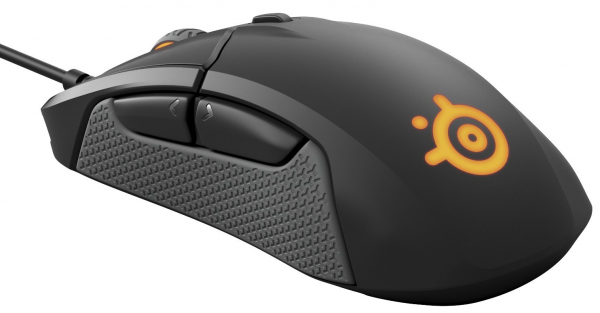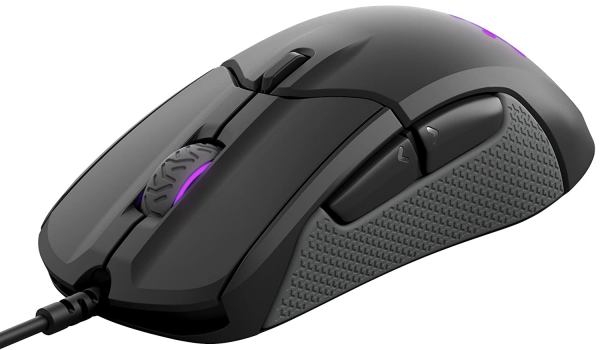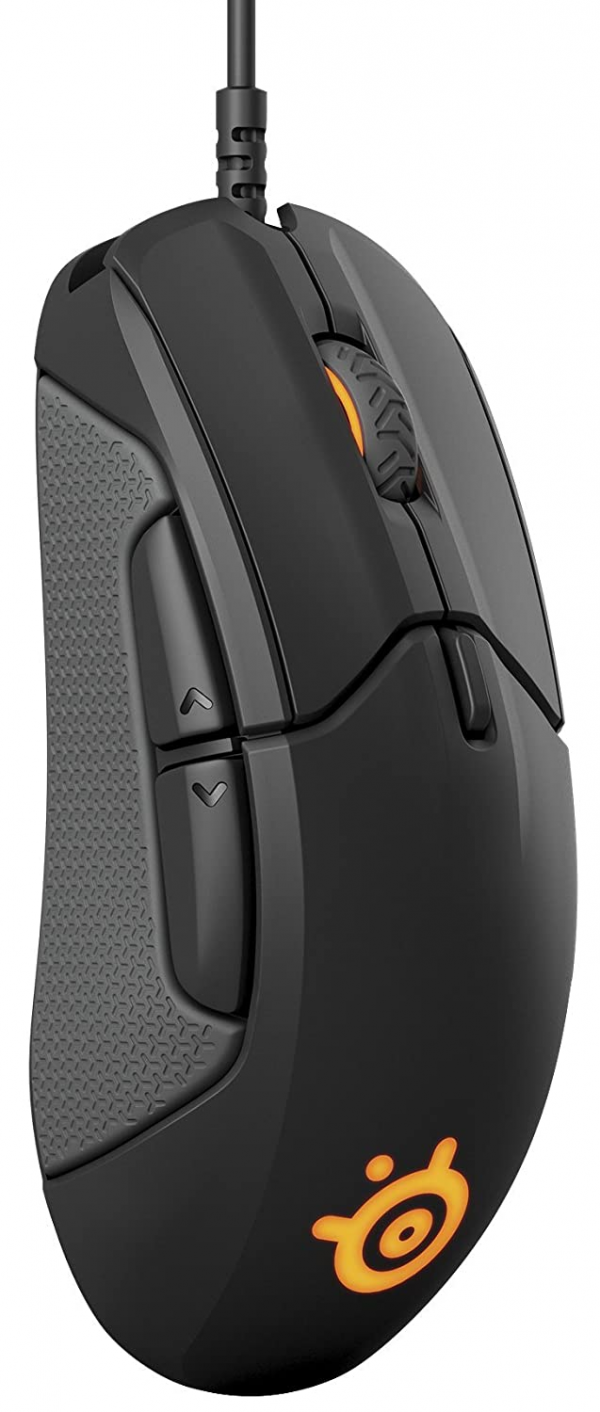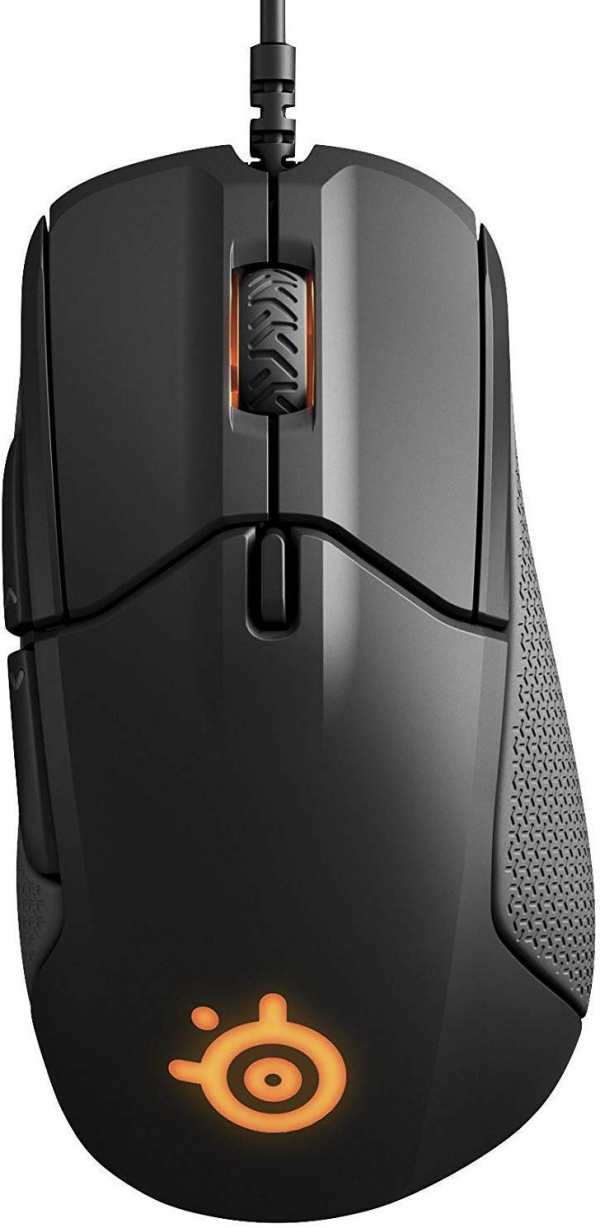SteelSeries
SteelSeries Rival 310: comfort and precision, no frills
Aprox. 74€ - see price -
See specificationsDeclension for right-handers of the Sensei 310, the Rival 310 differs from its ambidextrous sister only by its form. It thus adopts a design similar to that of the Rival 300, but modernizes its contours and especially its electronics, by equipping itself with an even more advanced optical sensor.
Positive points
Very good grip suitable for right-handers.
Good build quality.
High performance optical sensor.
Bad points
Only 2 configurable sensitivity levels.
Our review
Ergonomics
If the Sensei 310 is already rather pleasant to handle for a right-handed person, the Rival 310 proves even more convincing because of its design specifically thought to accommodate a right hand. It is thus tilted slightly to the right and better supports the palm thanks to its slightly more rounded shape, for greater comfort of use.
Its dimensions are more generous than those of the Sensei 310: 127.6 x 70 x 42 mm (the rear being - as on the Sensei - wider than the front: 57.2 mm at the front, 62 mm at the middle). You can thus put your hand entirely in it or hold it in your claw for a little more nervousness, when the Sensei 310 invites more to be taken with your fingertips. In any case, the big hands will be comfortable there.
Even lighter than the Sensei 310 with its 92 g approximately (SteelSeries announces 88.3 g without cable, but we measure a little more despite a placement of the cable outside the scale pan), the Rival 310 is very easy to handle. Its non-slip edges also improve grip and allow the mouse to be lifted easily. SteelSeries specifies that the latter are coated with "pure silicone" which would offer "an extremely durable grip". Beyond the obvious marketing arguments and even if we can not verify this claim in just a few weeks of use, it is true that this coating appears resistant and nevertheless flexible and pleasant to the touch. So let's hope that it will resist wear well, especially since SteelSeries is clearly targeting eSport this time with its new mice, synonymous with intensive use.
This is probably also why the plastic of the shell, with a matt appearance, offers a semi-rough feel. It thus appears robust and makes it possible to limit the sweat and the fingerprints that go with it. If the soft plastics are certainly more pleasant under the fingers, the one used on this mouse is not unpleasant however and turns out to be less messy.
As for the buttons, it's a bit the minimum service for the Rival 310 which only offers 6, but it will still follow the vast majority of users. The two buttons are based on Omron switches guaranteed for 50 million activations. They offer free clicks and respond perfectly well. If their activation is not particularly silent, it turns out to be quite deaf and therefore not very annoying to the ear. The click wheel is also discreet, fairly firm, while being easy to activate. But the main difference with the Sensei 310 is in the edge buttons. Present only on the left edge, mouse for right-handers requires, they are indeed much wider and therefore even easier to handle. Finally, a last button finds its place above the wheel, used by default to switch on the fly between the 2 sensitivity settings of the sensor.
The wheel itself benefits from the same silicone coating as the edges and therefore grips the finger well. Its low overshoot compared to the mouse shell allows quick access. Although notched, it is nevertheless quite silent. It simply lacks a horizontal scroll which, if it is not necessarily used in all games, is sometimes useful in office use - rare being the users who only play with their mouse.
As far as sliding is concerned, nothing to complain about, the three PTFE pads play their role perfectly and ensure fluid and relatively silent movements, both on soft and hard surfaces. However, it is always recommended to use a mouse pad to improve gliding, reduce noise and preserve skates.
In terms of personalization, forget the small removable and customizable appendage of the Rival 300, the Rival 310 made in the purest sobriety and we will not complain. Color lovers will be comforted by the independent adjustment of the RGB backlight on the dial and the logo. We preferred to deactivate the latter, too disturbing to our eyes in the dark when our hand is not on the mouse, but everyone will be free to choose the effect they prefer.

Precision
The Rival 310 swaps the Pixart PMW3310 optical sensor of the Rival 300 with a brand new sensor called TrueMove 3. Developed in partnership with Pixart, it is based on the PMW3360 which equips many other optical mice. If SteelSeries promises that it is designed specifically for eSport, it is very difficult in practice to accurately detect any differences in behavior compared to other equivalent sensors, whether they are named PMW3360 (Asus ROG Gladius 2 and many others), PMW3366 (G403 and other earlier Logitech mice like the G502), PMW3367 (Corsair Glaive RGB), PMW3361 / Owl-Eye (Roccat) ... For good reason, all these sensors offer high performance and reach speeds already much higher than those that a human arm can reach . The fact remains that precision and responsiveness are indeed there. We expected no less from a sensor capable of absorbing accelerations of up to 50 g and operating with a maximum capture speed of 8.9 m / s. 1: 1 optical tracking over a sensitivity range of 100 to 3,500 dpi completes these remarkable benefits.
If the maximum sensitivity can also climb up to 12,000 dpi, remember that, in practice, it is still useless, even counterproductive, to try to use your mouse at such a level. At 12,000 dpi, a movement of less than a centimeter is enough to cover the entire width of an Ultra HD screen; as much to say goodbye to precision in these conditions. Whatever our choice, however, the mouse responds to all requests, whether we play in low or high sensitivity, but it is indeed in the range of 100 to 3500 dpi that it will behave the best.
Surface recognition is also very good, the Rival 310 tolerating many coatings except glass and other transparent or too reflective surfaces. However, in the case of a gaming mouse, it would be a shame not to use a good mouse pad.

Conclusion
Nice evolution of the Rival 300 than this Rival 310. Even more pleasant to handle, more robust and equipped with an excellent optical sensor, it has enough to satisfy a lot of right-handed players looking all the same for a certain comfort.

Specifications

